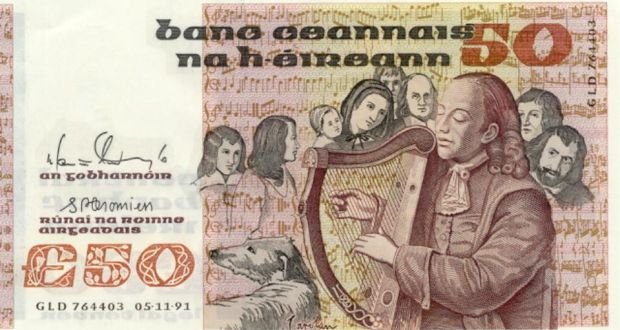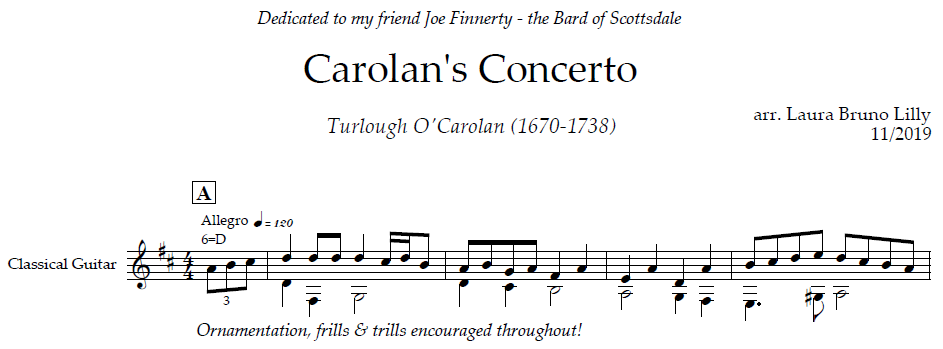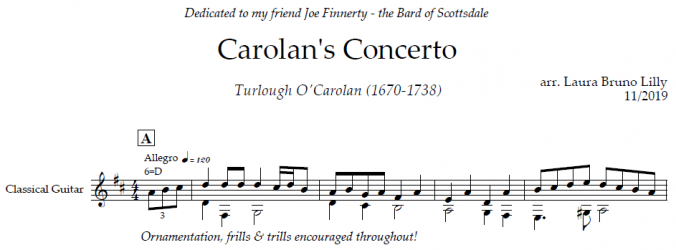Background
Turlough O’Carolan.
Most Celtic music enthusiasts and instrumentalists are familiar with this man’s body of work and prominence of place within the Irish folk tradition.

Long credited as being Ireland’s national composer, Turlough was born in 1670 and lived during the Baroque Era* of Western musical history. That Baroque reference is important to note. While traveling the lands of the Emerald Isle as an itinerant harper, he was in fact a contemporary of Scarlatti, Geminiani and Corelli – all composers of varying prominence of the day.
Put another way: Turlough O’Carolan could be called the Baroque Bard of Ireland.
My off-the-cuff quip notwithstanding, a rich mingling of musical traditions is indeed the basis of Carolan’s Concerto.
“In Carolan’s time, there were three musical traditions in Ireland – art music, folk music, and the harper tradition. The harper tradition served as a link between art and folk music and was the main conduit for the oral tradition. Carolan created a unique style by combining these art forms, and then adding elements inspired by Italian music which was then fashionable in Ireland. He was a great admirer of Vivaldi and Corelli, whose modern music he would have heard in the homes of his noble Irish patrons, and this admiration is reflected in the melodic construction and forms of many of his pieces. In fact, it’s said that his Carolan’s Concerto was a winning response to a compositional challenge from Geminiani, an acquaintance, colleague, and contemporary.”
Bridget Haggerty, Tribute to Turlough
My Take
Shortly before the beginning of the infamous New Year of 2020, I earnestly tackled composing an arrangement of this piece.
I wanted to adapt it for solo classical guitar in like forever and was pleasantly amazed at how it came together so quickly. I even produced two possible endings and put them up for a vote with my son and son-in-law – both musicians.
Consensus: First ending.
My take on Carolan’s Concerto was proving to be a breath of fresh air and loads of fun.

Within weeks of that previously mentioned infamous New Year of 2020, I started serious practice of my new arrangement.
General impression: It is good. It is a completed piece.
(NOTION score computer playback)
A computer generated playback of my arrangement of the Celtic tune Carolan’s Concerto, written by the blind Irish Bard – harpist, troubadour and composer – Turlough O’Carolan (1670-1738).
It was also too fast for me to play a tempo.
Discouraged, I set it aside.
Until a few weeks ago. That’s when I pulled it out for a re-look and when the ‘obvious’ hit me.
Why not play it anyway? Who says it has to be performed at such a scathing tempo?
Besides, the traditional tempo set for that piece is also traditionally variable.
Here’s the thing:
Not every guitarist is a shredder, lightening fast player. Plus, my arrangement is not a single line ‘solo’ that can be easily ‘shredded’!
Even after properly practicing certain passages of the piece at slower tempos and then speeding them up incrementally I may never get it up to the tempo as played in the above video.
So what?
Play it. Just. Play it.
“Some players are simply faster than others, the way some athletes are faster, bigger, stronger, etc. Still, none of that means ‘better.’ So, find your own performance tempo, and then bring more of yourself to the piece. Remember, you possess your own sound, tone, phrasing, attack, texture, etc. If you highlight those qualities, I promise you, no one will ever complain about the tempo.”
Shawn Persinger, Wood & Steel magazine, vol 99, Issue 1, 2021
*period or style of Western art music composed from ~1600-1750. A good synopsis of the times, characteristics and elements of the music can be found here.
